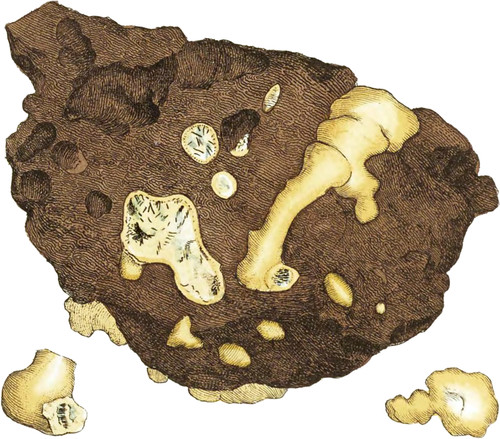 Enlarge
Enlarge
British Mineralogy
Compact Analcime
- Class 2. Earths.
- Order 1. Homogeneous.
- Gen. 4. Silex.
- Spec. 8. Analcime.
- Div. 3. Amorphous.
- Syn. Analcime. Haüy, v. 3. 180.
This curious substance is not uncommon in Great Britain, wherever basalt and trap are found. We have some specimens from different parts of Scotland, which contain it in nodules. The present specimen came from the Isle of Isla. It is somewhat stalactitical, and extremely various in its shapes, sometimes forming roundish drops from the size of a pin’s head to that of a large pea, and often of a knotty elongated figure like a potatoe. It seems to be a transition from quartz, and decomposes into filaments forming zeolite. This specimen exhibits it beginning to form the filaments. The bottom of the larger mass, which somewhat resembles the femur, or thigh bone, of an animal, appears once to have been a thick fluid state, and might have some idea of the forming of the flints in chalky rocks, (see page 15.) which however is not quite satisfactory to me. More of this will be mentioned in another place. They may be found somewhat various in their colours. The most common are nearly as here represented; transparent white or glassy, and often pearly or greyish within; the outside being coated with a light brown crust often nearly opaque, which gives an idea of fresh cast wax. The fracture is irregular, glassy or flinty. Analcime may be found in most of these appearances so hard as to resist a knife, like quartz; but in the state of compact zeolite, or passing into fibres, it may be scratched with a knife or any steel instrument, though it resists iron and brass. We are not sure that this is the true hyalite of Kirwin; who says it does not fuse per se at 150°. Ours fuses per se at the heat which turns carnelian white, which Kirwin observes was 160°.

